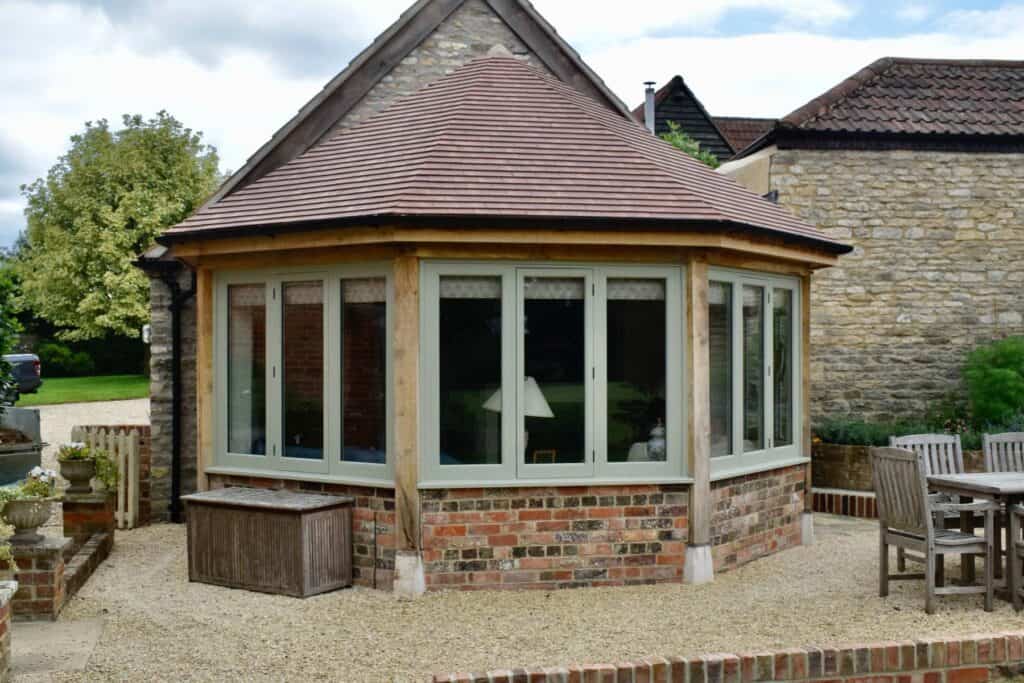When you’re looking to extend your home into the garden, or create a space for work or play, oak outbuildings create a perfect opportunity to add an additional room without the hassle and challenges. But what are the rules and regulations when it comes to outbuilding planning permission? From size limits to eaves and roof height, there is plenty to consider for a successful build.
Do you Need Planning Permission for Outbuildings?
Thankfully, over the last few years planning regulations for outbuildings have eased. The updated regulations mean that homeowners that want to build an outdoor shelter, outbuilding, summer house or office, will not often not need to apply for planning permission. But it is worth noting that there are some exceptions to bear in mind.
The latest rules that state if you can extend or add to your home without the need to apply for planning permission came into action on the 1st of October 2008. The new limits mainly apply to the size of the proposed addition, where it’s positioned in relation to the house and how close it is to the boundaries of the main property.
What are the Building Regulations for Outbuildings?
For summer houses, sheds and detached garages, no building regulations approval is required if:
- The building is under 15 square metres and has no sleeping accommodation.
- The building is between 15 and 30 square metres, has no sleeping accommodation, and:
- Is at least 1 metre from any boundary, or
- Is built primarily with non-combustible materials.
For an attached carport, building regulations approval won’t be required if the carport is open on at least two sides, and under 30 square metres. Attached garages will usually require building regulations approval, however.
How Big Can an Outbuilding Be Without Planning Permission?
Wondering what size an outbuilding can be without planning permission? There are some requirements that you need to match regarding size, including the necessity for the outbuilding to occupy no more than 50% of the space around your home. Following this, the maximum size of an outbuilding without planning permission is 15 metres long and 5 ½ metres deep. For properties in designated land such as National Parks, The Broads, Areas of Outstanding Natural Beauty, World Heritage Sites or conservation areas, this changes slightly. If your outbuilding is more than 20 metres away from any wall of the house, the maximum size of your outbuilding is 10 square metres.
As for the eaves, these should not be higher than 2.5 metres and the building overall has to be a single-storey construction with a total height of 3 metres. Another caveat is if the outbuilding is placed within 2 metres of the main building then this is lowered to a maximum of 2.5 metres.

Can you Build an Outbuilding Under Permitted Development?
If you’re planning to construct an outbuilding to the side or back of your home within a permitted development, in most cases you won’t need to worry about planning permission.
Outbuilding Permitted Development Size
This fits within the rules of the build taking up 50% or less of the outdoor space, being ancillary to the main building, but not being deemed as a separate dwelling. In the case of building near a fence, it can’t be any higher than 2.5 metres if within 2 metres. It’s also wise to research your local legislation if erecting near to a neighbour’s boundary.
If you’re building an outhouse further than 2 metres away from the fence then it can be as tall as 4 metres, but if it doesn’t have an apex roof it can be no higher than 3 metres, or no taller than 2.5 metres with eaves regardless of the style of roof. Do note that a listed building will need planning permission in general.
Eaves and Roof Height
As for eaves, these shouldn’t be any taller than the existing height of the eaves on your home and the roof ridge line. If your outbuilding is set to be within two metres of your property, then the eaves shouldn’t go beyond 3 metres in order to be permitted as a development.
Outbuilding Finishing
We all want our outbuilding to look stylish and in keeping with the rest of our exterior design, but how you implement this could be the difference between success and failure in an application.
Decorative architectural assets such as crestings which run along the roof’s ridge or raised platforms could cause some issues in your application so ensure to read what periods of architecture are passable. Keep it simple with a plan that matches your current planning rules as this could save you time and money when avoiding a possible rejection which will then have to be revised.
Building an Outbuilding in the Front Garden
When considering the location of an outbuilding, it’s important to know placing it on the side of your house that faces the road – also known as the principal elevation – would require planning permission. This is the case even if other criteria for permitted development are met, meaning outbuildings in the front garden typically aren’t permitted.
Limits and Restrictions for Outbuilding Planning Permission
From permitted development rules to size and height limits, there are restrictions to bear in mind to protect the rights of your neighbours and the local environment. Think about the materials you’re using and whether you’ll need proper draining installed as well as water and electricity – where is this supply going to come from and are there extra factors you need to include in your permitted development application? Keep an eye on local planning authorities as they may have variations or additional requirements for your area.
To Sum Up Outhouse Planning Permission
“Do I need planning permission for an outbuilding?” is one of the questions we get asked most often at Timberpride. If you’re still unsure, we’re here to help – our professional and highly knowledgeable team can assist and guide you with the development of your outbuilding to produce successful results all around and a stunning addition to your property.
Outbuildings are a wonderful addition to any home or piece of land and can open up plenty of opportunities for use when adhering to the right outbuilding regulations. They can also add value to your home too.
Our sustainable hand-crafted oak frames are tailor-made to your requirements using the finest materials whilst keeping sustainability and habitat conservation at the heart of Timberpride.
Frequently Asked Questions
We’ve gone through some of the most common questions on planning for outbuildings below.
A summer house follows the same rules as an outbuilding under permitted development allowances because it’s considered “incidental to the enjoyment of the dwellinghouse.” This means that the summer house is used for purposes that complement your main home, like a space for relaxation, hobbies, or storage, rather than as a separate living area.
In most cases, you won’t need planning permission as long as it meets a few key guidelines. For example:
- It can’t be positioned in front of the principal elevation of your house (the side that faces the road).
- It can’t be more than a single storey.
- If it’s within 2 metres of a boundary, the height must be 2.5 metres or less. If it’s further away, you can go up to 4 metres with a dual-pitched roof.
- The summer house, along with any other outbuildings, can’t take up more than 50% of the land around your original house.
- It also can’t be used as a separate, self-contained living space.
By keeping within these limits, you can usually avoid needing summer house planning permission. At Timberpride, we make sure our handcrafted summer houses meet all the necessary regulations, so you can enjoy a stylish, sustainable addition to your garden without the worry of legal hassles.
As of April 25th, 2024, the previous 4 year rule has been replaced by the 10 year rule for outbuildings, for all of the UK except for Wales. According to the Town and Country Planning Act 1990, the 10 year rule allows an outbuilding to become lawful if it has been constructed and used continuously for a period of 10 years without enforcement action from the local authority. After this time, the building is considered immune from enforcement, meaning it can no longer be required to be demolished or altered, even if it didn’t originally have planning permission.
However, we would advise against relying on the 10 year rule as it is extremely risky. Local authorities have the right to require you to demolish your building if it’s built without planning permission, at any point during the 10 year span.
Outbuilding regulations in the UK primarily fall under permitted development rights, which allow you to construct certain types of buildings without the need for planning permission.
Strictly speaking no, you don’t have to do anything, but it is often a good idea to apply for a certificate of lawfulness so that there is a record of your build which will legitimise it. This is particularly useful when a subsequent buyer performs searches for a mortgage.

